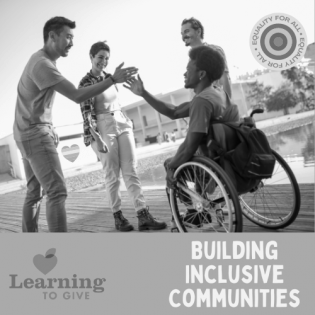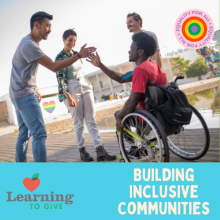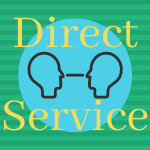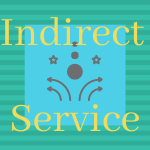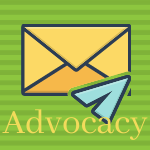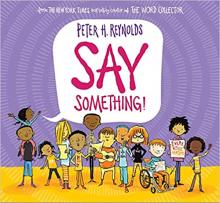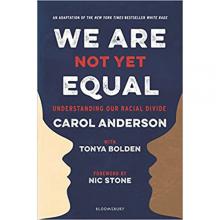Inclusive Communities
This toolkit guides youth, educators, group leaders, families, and community groups as they facilitate building inclusive communities and prepare to take action. Contents:
- Current story
- Definitions
- Key questions
- Background
- Lessons and activities
- Resources in your community
- Project ideas and guide to service-learning
- Quotes
Including and Celebrating All Young People in the Community
Ensuring that all people feel included, supported, and seen is the work of building a community. Youth of all abilities may serve as culturally competent peers and ambassadors for their peers who are marginalized or misunderstood.
Be an Activist for Inclusion! Using your voice to right a wrong and improve the world is a superpower.
Bellen Woodard, at the age of 9, noticed that her classmates considered only the peach-colored crayon to be “skin color,” which didn’t feel right. After talking to her grown-ups, Bellen decided to change the language in her classroom. After that moment, when a friend mentioned a “skin color crayon,” Bellen would ask “which one?” Bellen is now the owner of her own company--More Than Peach--and a Crayon Activist. Watch this video interview to see how Bellen used her voice to make her community (and the world) better.
More Than Peach Project:
Definitions and Key Questions
See the handout below for Vocabulary and Key Questions related to inclusion.
Definitions
- Person-first language
- Anti-racism
- Mental health
Key Questions
- In what ways have you felt or observed someone else excluded or not valued?
- What are the dominant cultures in your community? How are people in non-dominant groups treated?
- What can be done differently to make all young people feel included and valued?
Youth Ambassadors for Inclusion
Ensuring that all people feel included, supported, and seen is the work of building a community. Youth of all abilities may serve as culturally competent peers and ambassadors for their peers who are marginalized or misunderstood. Allowing youth to serve as culturally competent ambassadors in their spaces is important for the following reasons:- Young people both want to and have the capacity to be leaders. Allowing youth to serve as ambassadors between peers or between youth and adults is a leadership role that can make meaningful change in their spaces.
- Anti-bullying programs teach the concept of being an upstander - someone who sees harm being done and speaks out against it. Upstanding does not need to be limited only to bullying; people can speak up and speak out to ensure that their spaces are inclusive of all youth regardless of culture, ability status and mental wellness.
- Young people with disabilities also deserve the opportunity to participate in philanthropy and be partners in advocacy. Including these youth in the ambassador program is a tangible example of inclusion at work and encourages all youth to have agency.
Recruit interested youth. In a school setting, this can be an after-school club. In other community groups, this might be the entire group (e.g. scouts, Youth Advisory Board) or a subgroup. See the invitation sample below.
Ambassador Activities:
- Train youth over the course of 4-6 sessions using Learning to Give’s Cultural Competence lessons. Start with suggested lessons. If the group would like to dive deeper, the full Cultural Competence guide and lessons are linked below).
- Meet with the group regularly to explore topics that are relevant in their communities. This might include pre- and post-surveys related to needs in the community.
- You may dive deeper into what interests the group and connect with nonprofits in your community. Explore the ideas in this toolkit and across the Learning to Give website.
- Invite the club members to take action and speak up as ambassadors. There are many ideas for service projects below.
- Also, frequently reflect through discussion (and other creative methods) and get feedback from club youth and their peers about their experience. This might include pre- and post-project surveys related to needs in the community.
Lessons and Activities
- Disabilities and Inclusion: Many youth and adults aren't aware of the types of disabilities people have and may not know how (or be comfortable enough) to interact and befriend people with disabilities in a meaningful way. In these two lessons, participants learn about many different types of disabilities, which education-related disabilities are most prevalent in their own community, and ways to be allies of people with disabilities.
Lesson One - The Language of Disability
Lesson Two - Understanding Disabilities - Race and Racism: Our diverse populations may not be reflected in leadership and services to the community. An understanding of race helps young people combat racism in their day-to-day language and behavior. In these two lessons, participants reflect on the racial demographic of their community and differentiate the concepts of race vs. ethnicity, racism and anti-racism.
Lesson Three - Race and Ethnicity
Lesson Four - Anti-Racism - Cultural Celebrations: Schools and organizations tend to center on Christian holidays and celebrations, leaving out youth who celebrate other occasions or don’t celebrate holidays at all. In this lesson, participants learn about the special days and observances of non-dominant cultures, recognize commonalities in holiday celebrations, and create a culturally inclusive calendar of events.
Lesson Five - Celebrations Around the World - Mental Health Awareness: Young people are talking about mental health and have questions about how to help themselves or others. In this lesson, participants identify mental health warning signs as well as resources to get help. Included are some helpful crisis resources for youth to keep on hand.
Lesson Six - Mental Health - Critical Conversations: Equipped with knowledge about physical and neuro-diversity, youth practice communication techniques that help them speak up in a way that is productive and respectful. In this lesson, participants identify causes about which they will use their voice and actionable steps to make a change in the community.
Lesson Seven - Critical Conversations
Lesson Eight - Using Your Voice
Cultural Competence Guide
These lessons and activities can serve as extensions to the learning in this toolkit. This Cultural Competence Facilitator's Guide is made up of fifteen activities for families, clubs, or classrooms. We provide materials and guidance for any adult working with youth from ages 5 to 15 to build their awareness of the richness of cultures in the world and respect for diverse people. With a vision of building a life of generosity and community engagement, these activities engage youth in taking personal responsibility for the good of all through words, intentions, and actions. These activities align with SEL.
Community Resources
Connect youth to people and nonprofit organizations and natural resources in the local community related to inclusion of all types. This is an opportunity for a field trip (may be virtual) or for an expert to teach about issues and what is already being done. Youth may write, call, or interview experts about needs and partnerships.
- School board
- Peer mentors and peer mediators
- Community mental health agencies
- Disability education or disability rights groups
- Cultural centers
- History museums
Service Project Ideas
There are four types of service. The ideas below are grouped by these types. The best service-learning experiences follow the passions of youth and local concerns. These are provided to start conversations and ideas.
This overview Guide for Planning Service-Learning describes each step of the process and actions to take.
This blank chart for Planning Service-Learning helps youth prepare for who does what for maximum service and learning impact.
- Design a “buddy bench” project.
- Serve as a guide to new students (or group members) during their first week.
- Neurotypical students serve as designated peer supports for youth with disabilities (i.e. during partner projects).
- Include students with disabilities in activities and your social group.
- Volunteer to mentor in a self-contained special education classroom (book buddies, play games, attend recess or lunch times, etc.).
- Serve as mentors in ELL programming ((book buddies, play games, do language drills, etc.).
- Regularly decorate a bulletin board to raise awareness of diverse people and accessibility.
- Plan an awareness or cultural celebration event for families.
- Do morning announcements with fast facts or encouraging ideas.
- Design and carry out a fundraiser for a mental health organization.
- Advocate for classroom celebrations to be culturally inclusive.
- Write a letter to your city council, representative, or school board regarding treatment of marginalized populations - Letter Writing Project Plan.
- Make a group presentation to raise awareness for a cause or topic.
- Create a cultural traditions calendar of holidays, awareness months or days, and relevant events to distribute to teachers and the community.
- Audit a bookshelf to assure representation of cultures and diverse perspectives - Project Plans.
- Conduct a community audit of accessibility (e.g. looking for curb cuts on sidewalks, and automated doors).
Literature Guides
Learning to Give picture book and teen novel guides combine selected literature with thought-provoking discussions and activities about empathy, respect, kindness, inclusion, perseverance, responsibility, generosity, and citizenship.
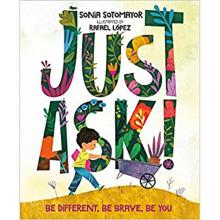
In this book, Just Ask! Be Different, Be Brave, Be You by Sonia Sotomayor, Sonia and her friends share what is unique about each one of them as they work together to plant a garden. It is their differences that make the garden diverse and beautiful. The reader is invited to consider how they interact with the world and the ways they are different from everybody else.
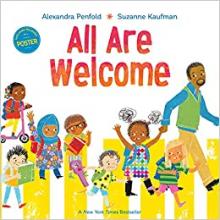
All Are Welcome Here literature guide includes before, during, and after-reading discussion questions. School is a community where diversity is celebrated and people of all backgrounds, abilities, and appearances are welcome. This book is a rhythmic colorful tour of the first day of school and all of the activities taking place.
Say Something reminds us that each of us, each and every day, has the chance to say something in a way that suits us individually. Perfect for youth activists everywhere, this timely story reminds readers of the undeniable importance and power of their voice.
We Are Not Yet Equal is an adaptation for young people of the New York Times Bestselling book, White Rage. This book received several accolades including an NAACP Image Award finalist book and a NYPL Best Book for Teens. It helps build understanding of the story of civil rights and race relations and what it means in the current world they are living.
Quotes
“When you know better, do better.” – Maya Angelou
“Spend your privilege.” – Brittany Packnett
"What's the point of having a voice if you're gonna be silent in those moments you shouldn't be?" – Angie Thomas, author of The Hate U Give
“My advice to other disabled people would be, concentrate on things your disability doesn’t prevent you doing well, and don’t regret the things it interferes with. Don’t be disabled in spirit as well as physically.” – Stephen Hawking
“Start by doing what’s necessary; then do what’s possible; and suddenly you are doing the impossible.” – Francis of Assisi
“Your success and happiness lies in you. Resolve to keep happy, and your joy and you shall form an invincible host against difficulties.” – Helen Keller
"To make clear, Autism is not something that makes you better than others. Nor is it a condition/disorder that necessarily disables you.
It’s simply something that makes you different, and in a world where everyone strives to fit in, being different is a strength." – Greta Thunberg
